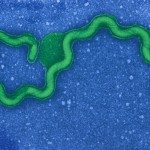Link to Pubmed [PMID] – 18451039
Microbiology (Reading, Engl.) 2008 May;154(Pt 5):1309-17
Leptospires exist as saprophytic organisms that are aquatic or as pathogens that are able to survive in water. Leptospirosis is transmitted to humans through environmental surface waters contaminated by the urine of mammals, usually rodents, which are chronically infected by pathogenic strains. The ecology of Leptospira spp. prompted us to evaluate if these spirochaetes were able to form biofilms. This study investigated the characteristics of biofilm development by both saprophytic and pathogenic Leptospira species using microscopic examinations and a polystyrene plate model. Biofilms were formed preferentially on glass and polystyrene surfaces. Electron microscopic images showed cells embedded in an extracellular matrix. The formation of such a biofilm is consistent with the life of saprophytic strains in water and may help pathogenic strains to survive in environmental habitats and to colonize the host.

